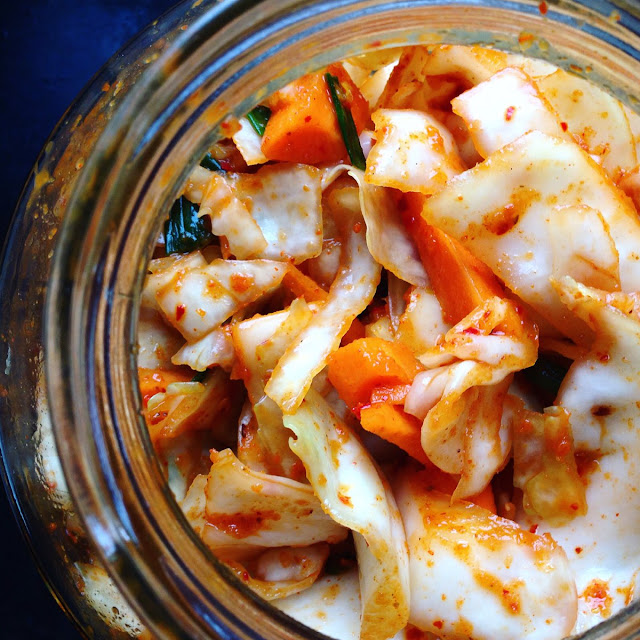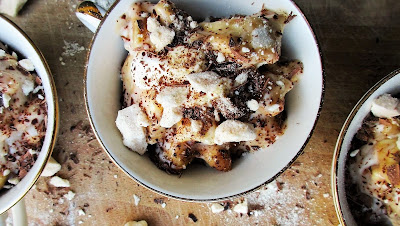how to make easy cabbage kimchi
 |
| how to make easy cabbage kimchi - recipes at De Tout Coeur Limousin |
Kimchi is a traditional korean dish of fermented vegetables - made by lacto-fermentation (the same process used in making sauerkraut). Fermentation has been used for centuries as a method of preserving food, and for the reported health benefits.
In lacto-fermentation the vegetables are first salted and soaked in brine which removes any harmful bacteria. In the next stage the good bacteria (lactobacillus) converts the sugars into lactic acid, which preserves the vegetables, and gives them their characteristic 'tangy' fermented flavour.
Fermented foods, such as kimchi, sauerkraut, kefir and kombucha are all reported to have many benefits for our health - and particularly our gut health.
You can read more about the health benefits of fermentation here:
the health benefits of fermentation
You can ferment a variety of vegetables for kimchi, and there are numerous recipes available, but this is for one of our favourites, for a simple cabbage kimchi.
This cabbage kimchi recipe has a few radishes and spring onions added for extra texture and flavour, and is spiced with a seasoning paste made with ginger, ginger, chilli flakes and (optional) fish sauce or kelp powder.
This kimchi recipe is for a simple cabbage kimchi - full of savoury umami, spice and crunch and just delicious. Kimchi adds a zing to your meals, as a side dish accompanying everything from traditional Korean dishes to burger and chips. Kimchi can be enjoyed raw, straight out of the jar, or added to your recipes too. It's really good in fried rice or noodle stir fries. Happy fermenting!
You can read more about kimchi here: kimchi
You can read more about kimchi here: kimchi
how to make easy cabbage kimchi
recipe preparation time: about 30 minutes plus extra standing/draining time
makes about 1 litre of kimchi
ingredients
1/4 cup sea salt
water
1 tablespoon grated garlic
1 teaspoon grated ginger
1 teaspoon sugar
2 to 3 tablespoons fish sauce/kelp powder/water
1 to 5 tablespoons Korean red pepper flakes (gochugaru)
4 spring onions trimmed and cut into 1-inch pieces
8 ounces radish or daikon peeled and cut into matchsticks (or combination or carrot and radish)
instructions:
Place the cabbage and salt in a large bowl. Massage the salt into the cabbage (gloves optional) until it starts to soften a bit, then add water to cover the cabbage. Put a plate on top and weigh it down with something heavy. Let stand for 1 to 2 hours.
Rinse the cabbage really well under running cold water, drain in a colander for 15 to 20 minutes.
Combine the garlic, ginger, sugar, and fish sauce (or vegan/vegetarian alternative) in a small bowl and mix to form a smooth paste. Mix in the chilli flakes to taste - using 1 tablespoon for mild and up to 5 tablespoons for spicy.
Gently squeeze any remaining water from the cabbage and return it to the bowl along with the radish/carrots, spring onions, and prepared seasoning paste.
Using your hands, gently work the paste into the vegetables until they are thoroughly coated. I would definitely recommend wearing clean kitchen gloves here - the chilli can be very strong on the skin.
Pack the kimchi into a clean and sterilized 1 litre jar, pressing down on it until the brine rises to cover the vegetables. Leave at least 1 inch of space at the top of the jar, then seal with lid.
Let the jar stand at room temperature for 1 to 5 days to ferment. Place a plate/bowl underneath the jar in case the fermentation is really lively and seeps out of the jar.
Check the kimchi daily, pressing down on the vegetables with a clean spoon to keep the vegetables under the brine. Taste the kimchi daily too - when the kimchi tastes ripe enough for your liking, transfer the jar to the refrigerator.
Recipe Notes
- vegetarian/vegan alternatives: For vegetarian kimchi you can use 3/4 teaspoon kelp powder mixed with 3 tablespoons water, or simply 3 tablespoons of water to replace the salty/umami flavour of the fish sauce.
- if you can't find gochugaru chilli flakes you can substitute with other red chilli flakes - but check the strength and use to your own personal taste.
recipe from: how to make easy kimchi
Watch the video of how to make easy kimchi here: how to make easy kimchi
Say bonjour & visit us at De Tout Coeur Limousin. Creative & well being retreats, holidays & workshops in the heart of rural Limousin, France
|
 |
| summer retreat - singing, meditation, good food and wellbeing |
















this looks interesting I'll have to try it out #BloggerClubUK
ReplyDeleteThanks Frankie. A favourite here ☺
Delete